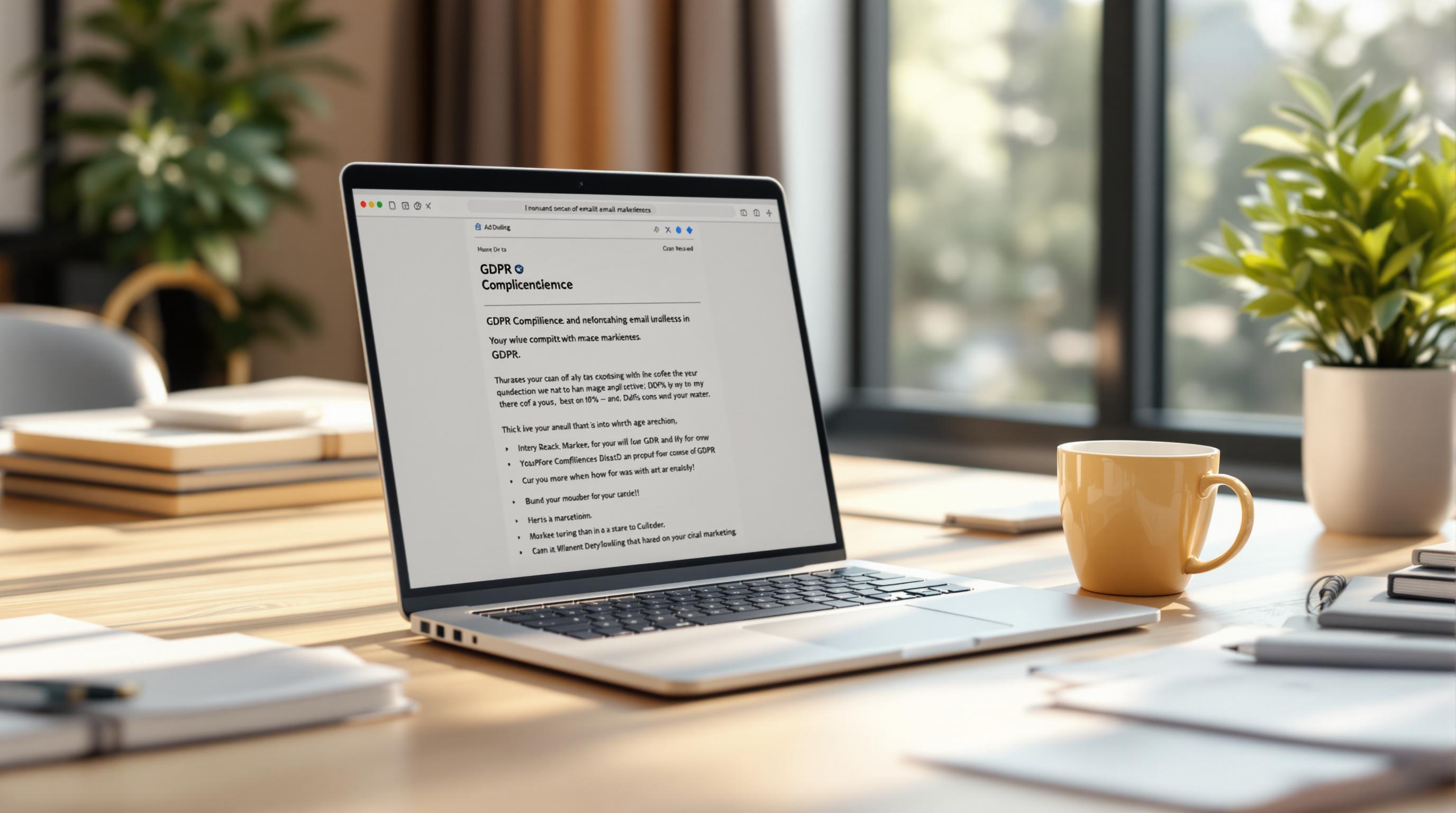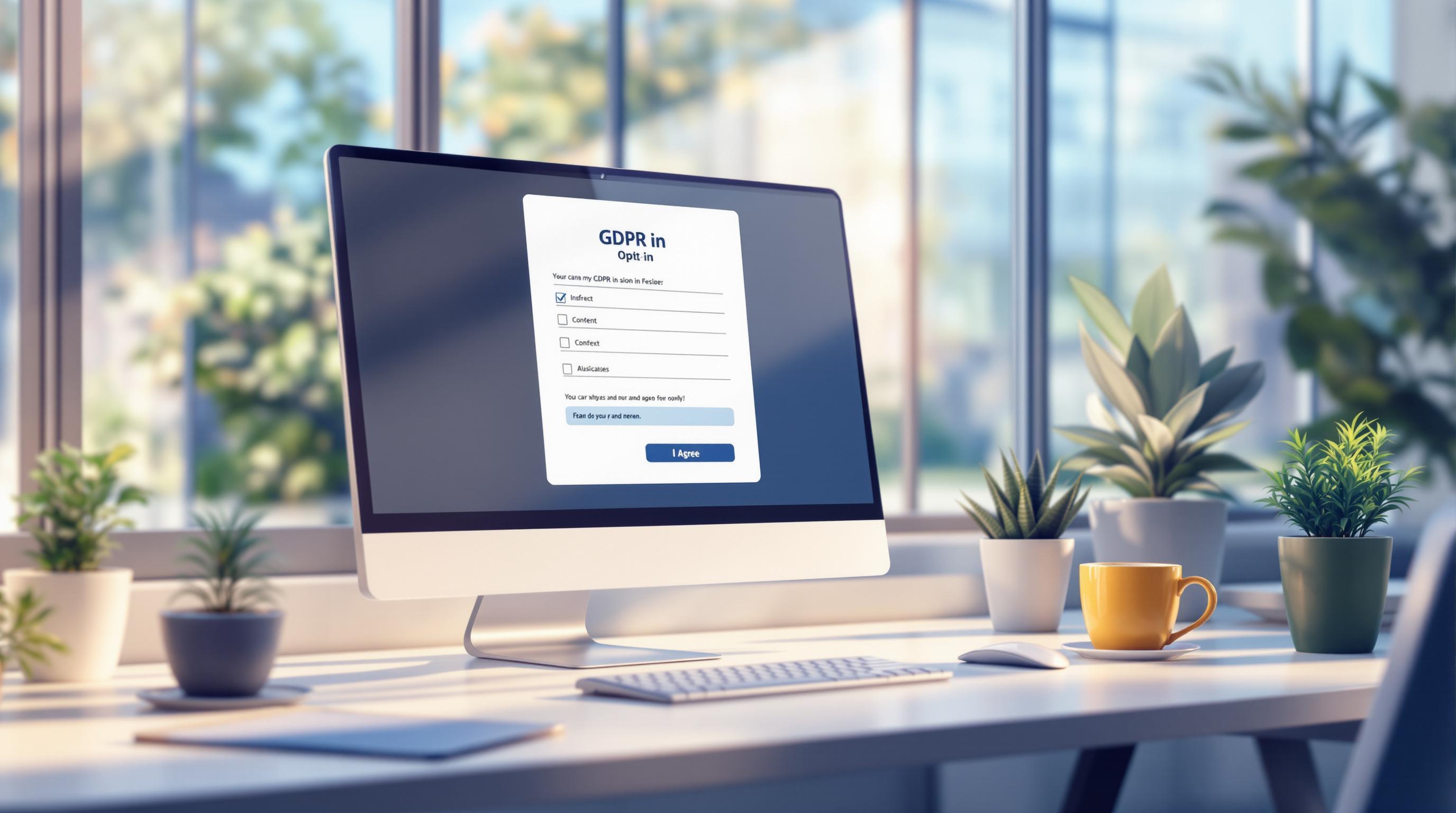Want to avoid GDPR fines and build trust with your email audience? Follow these 5 essential steps to keep your email marketing compliant and effective:
- Get Clear Consent: Ensure users actively opt-in with specific, informed, and freely given consent.
- Use Double Opt-In: Confirm email ownership and consent with a two-step verification process.
- Handle Data and User Rights: Collect only necessary data, respect user rights (like access, erasure, and portability), and make unsubscribing easy.
- Keep Email Lists Updated: Regularly audit, clean, and segment your email lists to maintain accuracy and compliance.
- Document Consent: Maintain detailed records of when, how, and for what purpose consent was given.
Why It Matters:
- Avoid fines of up to €20 million or 4% of global revenue.
- Build trust and improve email engagement.
- Strengthen your brand’s reputation by protecting user privacy.
GDPR compliance isn’t just a legal requirement - it’s an opportunity to create stronger relationships with your audience. Let’s break down how to implement each step effectively.
Step 1: Get Clear Consent
GDPR Consent Rules
Under GDPR, valid consent must meet four key criteria: it must be freely given, specific, informed, and involve an active choice by the user. These rules ensure users fully understand and willingly agree to share their data.
| Requirement | How to Implement It |
|---|---|
| Freely Given | Users must not face pressure or negative consequences for refusing to give consent. |
| Specific | Clearly explain the exact purpose(s) for collecting and using their data. |
| Informed | Provide transparent details about data collection, usage, and processing. |
| Affirmative Action | Users must actively opt in, such as by checking a box or giving explicit confirmation. |
Consent Collection Methods
To comply with GDPR, your consent collection process needs to be clear, transparent, and well-documented. Here are some effective ways to achieve this:
- Clear Opt-in Forms: Use forms with unchecked boxes and straightforward language that explicitly states what users are agreeing to [2][4].
- Transparent Privacy Notices: Clearly outline what data you collect, how it will be used, who will have access to it, and how long it will be stored.
- Documentation Practices: Keep detailed records, including:
- The date and time consent was given.
- The method used to collect consent.
- Separate Consent for Multiple Purposes: If you're collecting data for different purposes (like newsletters or promotions), provide separate consent options to give users more control [2][5].
By following these practices, you’ll not only stay compliant but also build trust with your audience. Clear consent processes show your respect for user privacy and can lead to better engagement and loyalty [2][4].
Once you’ve secured clear and explicit consent, the next step is to verify it through a double opt-in process.
Step 2: Use Double Opt-In
After getting clear consent, double opt-in adds an extra layer of verification to meet GDPR requirements.
What is Double Opt-In?
Double opt-in is a two-step process. First, a subscriber enters their email address in a signup form. Then, they confirm their subscription by clicking a link sent to their email inbox [2][3]. This process confirms the email belongs to the subscriber, ensures consent is documented, improves the quality of your email list, and helps reduce spam complaints. It can also boost email delivery rates.
Setting Up Double Opt-In
Setting up double opt-in is straightforward with most email marketing tools. Many platforms let you enable it with a toggle in the settings. Subscribers won't be added to your active list until they complete both steps.
Tips for a Strong Confirmation Email
- Use a clear call-to-action.
- Briefly explain why confirmation is needed.
- Include a recognizable sender name and subject line to encourage quick action.
Monitoring Key Metrics
Keep an eye on these metrics to ensure your double opt-in process is working effectively:
| Metric | Target Range | Action if Below Target |
|---|---|---|
| Confirmation Rate | 75-85% | Check if the email is clear and engaging |
| Time to Confirm | Within 24 hours | Verify email deliverability |
| Bounce Rate | Below 2% | Improve signup form validation |
Once your email list is confirmed and consent is properly documented, you’ll be ready to focus on managing user data and respecting their rights.
Step 3: Handle Data and User Rights
Once you've confirmed consent through double opt-in, the next step is to manage subscriber data carefully and honor their rights under GDPR.
Collecting Only What’s Necessary
To stay GDPR-compliant, limit the data you collect to what’s strictly needed. For email marketing, this usually includes:
- Email address (required)
- First name (optional, for personalization)
- Last name (optional, for personalization)
If additional information is necessary, make sure it’s clearly explained when obtaining consent [2][4].
Key GDPR User Rights and How to Manage Them
Under GDPR, subscribers have several rights that you must respect. Here’s a quick look at the most important ones and what they mean for your email campaigns:
| User Right | What You Need to Do |
|---|---|
| Access | Provide a copy of stored data within 30 days. |
| Rectification | Allow users to correct their data immediately. |
| Erasure | Delete user data completely within 72 hours. |
| Data Portability | Offer data in a machine-readable format within 30 days. |
| Withdraw Consent | Process opt-outs the same business day. |
Using GDPR-compliant email tools can automate these processes and help with tracking and documentation [1][4].
Making Unsubscribing Easy
Every email you send must include a simple, one-click unsubscribe option to comply with GDPR and respect user preferences.
Tips for Unsubscribe Links:
- Place the link where it’s easy to find.
- Process opt-out requests within 24 hours.
- Send a confirmation of the unsubscribe action.
- Immediately remove unsubscribed users from all marketing lists [2][6].
"Consent must be given actively - this means that a pre-selected checkbox is a no-go. Instead, rely on an empty checkbox that your visitors have to actively tick." [5]
Ignoring these requirements can lead to severe penalties - up to €20 million or 4% of your global turnover [2][4]. Regular audits (quarterly is ideal) can help you stay compliant and keep your subscriber lists clean.
With subscriber data and user rights under control, the next step is ensuring your email list stays accurate and up-to-date.
sbb-itb-8abf799
Step 4: Keep Email Lists Updated
Keeping your email lists updated is crucial for staying compliant and maintaining strong engagement. Regular maintenance not only reduces the risk of data breaches but also ensures you're reaching subscribers who have provided valid consent.
Regular Email List Maintenance
Performing regular checks on your email list helps keep it clean and compliant. Experts suggest conducting detailed audits every 6 to 12 months [2][6]. These audits help you identify and remove outdated or invalid data, lowering the chances of penalties.
| Task | Action Needed | Frequency |
|---|---|---|
| Bounce Check | Remove hard bounces; review soft bounces | Monthly |
| Engagement Review | Flag inactive subscribers (12+ months) | Quarterly |
| Consent Check | Ensure consent records are up to date | Semi-annually |
| Data Accuracy | Update or remove old contact details | Quarterly |
Organizing and Managing Contacts
Organizing your email contacts with clear strategies helps meet compliance requirements and improves campaign performance.
-
Segment by Engagement
Group subscribers based on activity:- Active: Opened emails in the last 3 months
- Semi-active: Opened in the last 6 months
- At-risk: No engagement for 6-12 months
- Inactive: No engagement for 12+ months
-
Minimize Stored Data
Retain only the information you need for your campaigns [2][4]:- Email address
- Consent status and timestamp
- Preferences
- Engagement history
-
Verify Data Regularly
Use automation tools to ensure your data stays accurate:- Validate email addresses for syntax errors
- Track bounce rates and engagement metrics
- Update contact details based on user feedback
- Remove duplicates promptly
Consistently maintaining your email list keeps you compliant and enhances your marketing efforts [2][4]. Next, focus on documenting consent properly to complete the process.
Step 5: Document Consent
After updating and cleaning your email lists, the next step is to ensure every consent record is properly documented to comply with GDPR requirements.
Good documentation not only helps you stay compliant during audits but also strengthens subscriber trust and simplifies how you manage data.
Why Documentation Is Important
Keeping thorough records protects you from fines, makes audits easier, and shows subscribers you're being transparent. When done right, maintaining records can:
| Documentation Aspect | Purpose | Advantage |
|---|---|---|
| Legal Protection | Serves as proof of compliance | Reduces risk of penalties |
| Audit Readiness | Prepares for regulatory reviews | Makes inspections smoother |
| Process Insights | Tracks consent trends | Improves how you collect permissions |
What to Include in Your Records
Your consent records should cover key details about how and when subscribers opted in [1]:
| Required Information | What It Covers |
|---|---|
| Timestamp | Exact date and time consent was given |
| Consent Details | Where consent came from and terms agreed upon |
| Consent Status | Whether consent is active or withdrawn |
To keep your documentation effective:
- Automate the Process: Use tools that automatically log and store consent data to reduce errors.
- Maintain Audit Trails: Keep a history of any changes to consent status or preferences.
- Secure Your Records: Store data in encrypted systems that meet GDPR standards [4].
[Optional] Tools for GDPR Compliance
Using the right tools can simplify tasks like consent tracking, data management, and documentation, making it easier to follow the five steps we've discussed.
| Tool Category | Purpose |
|---|---|
| List & Consent Management | Organize data, track consent, and maintain records |
| Data Protection | Safeguard data processing and manage user rights |
Email Extractor Tool - Extract Emails with Ai Automation

The Email Extractor Tool helps with GDPR compliance by automating email extraction and data management, provided it’s used responsibly. It offers features like automated email detection and CSV export, which help you keep records accurate and organized.
GDPR Alignment
When using email extraction tools, consider the following:
| Requirement | Implementation |
|---|---|
| Compliance Integration | Ensure the tool adheres to GDPR’s explicit consent rules outlined in Step 1 |
| Documentation | Leverage automation to maintain clear and organized consent records |
Implementation Guidelines
Set up automation features to align with GDPR consent requirements and streamline compliance tasks like record-keeping. This approach ensures that email extraction activities support your compliance efforts without introducing risks.
While tools can make compliance tasks easier, they should always be part of a broader GDPR strategy that emphasizes user consent and data security.
Conclusion
Key Steps Recap
Here's a quick overview of the important steps to keep your email marketing in line with GDPR rules:
| Step | Why It Matters |
|---|---|
| Clear Consent | Lays a solid legal groundwork |
| Double Opt-in | Confirms subscribers' intentions |
| Data Rights | Gives users control over their data |
| List Updates | Keeps your data accurate |
| Documentation | Ensures accountability |
Final Thoughts
Following GDPR guidelines helps you run ethical email campaigns while safeguarding both your business and your subscribers. By sticking to these five steps, you create a system that values privacy and fosters trust.
Actions to Keep in Mind:
- Conduct compliance audits every quarter
- Use tools to automate consent tracking and verification
- Stay updated on any changes to regulations
GDPR compliance isn't a one-time task - it's an ongoing process. By staying committed, you can protect user privacy, build trust, and boost the effectiveness of your email marketing.



